#zoo science
Explore tagged Tumblr posts
Text
Peruvian Viringo Dog


Patreon
#studyblr#notes#my notes#vetblr#veterinary science#vet science#vetsci#the dog#dogs#canines#dog breeds#dog health#dog physiology#medicine#health#dog medicine#animal science#animals#zoology#zoo science#canids#life science#health science#biology#biology notes#bio#bio notes#dog biology#dog bio#science
3 notes
·
View notes
Text
"In one of Africa’s last great wildernesses, a remarkable thing has happened—the scimitar-horned oryx, once declared extinct in the wild, is now classified only as endangered.
It’s the first time the International Union for the Conservation of Nature (IUCN), the world’s largest conservation organization, has ever moved a species on its Red List from ‘Extinct in the Wild’ to ‘Endangered.’
The recovery was down to the conservation work of zoos around the world, but also from game breeders in the Texas hill country, who kept the oryx alive while the governments of Abu Dhabi and Chad worked together on a reintroduction program.
Chad... ranks second-lowest on the UN Development Index. Nevertheless, it is within this North African country that can be found the Ouadi Rimé-Ouadi Achim Faunal Reserve, a piece of protected desert and savannah the size of Scotland—around 30,000 square miles, or 10 times the size of Yellowstone.
At a workshop in Chad’s capital of N’Djamena, in 2012, Environment Abu Dhabi, the government of Chad, the Sahara Conservation Fund, and the Zoological Society of London, all secured the support of local landowners and nomadic herders for the reintroduction of the scimitar-horned oryx to the reserve.
Environment Abu Dhabi started the project, assembling captive animals from zoos and private collections the world over to ensure genetic diversity. In March 2016, the first 21 animals from this “world herd” were released over time into a fenced-off part of the reserve where they could acclimatize. Ranging over 30 miles, one female gave birth—the first oryx born into its once-native habitat in over three decades.
In late January 2017, 14 more animals were flown to the reserve in Chad from Abu Dhabi.
In 2022, the rewilded species was officially assessed by the IUCN’s Red List, and determined them to be just ‘Endangered,’ and not ‘Critically Endangered,’ with a population of between 140 and 160 individuals that was increasing, not decreasing.
It’s a tremendous achievement of international scientific and governmental collaboration and a sign that zoological efforts to breed endangered and even extinct animals in captivity can truly work if suitable habitat remains for them to return to."
-via Good News Network, December 13, 2023
#chad#abu dhabi#north africa#rewilding#endangered species#conservation#zoology#conservation biology#oryx#good news#hope#texas#big game#animals#endangered#environmentalism#environmental science#zoo#zoos#zoo animals
25K notes
·
View notes
Text
Folk were really into the post I made about Tandie, the zoo lion with a (then) undergrown mane due a period of time on testosterone blockers. He's having quite the glow up this summer.
But!
Did you know that manes are hormone dependent in both sexes of lion?
Let's talk about maned lionesses!
To recap the previous post quickly: the existence of a mane, and it's color, appear to be pretty heavily androgen-dependent. Neutered males or males put on testosterone blockers, like Tandie was, will drop their manes - but like Tandie, if taken off the meds, it will generally grow it back. Darker manes are indicative of higher testosterone levels, and long/lush manes are generally a good signal of a male's fitness and mate quality. Females seem to show a preference for males with longer, darker manes and other males will preferentially avoid scuffles with them. (Yes, as many comments have pointed out, that means Scar was actually a hunk. Do with that as you will.)
The fascinating thing about androgens being linked to manes in lions is that it goes both ways - females with higher levels will also grow manes!
Mane growth in females lions is most commonly seen with elderly animals who have stopped cycling and are basically in lion menopause. And they have to get pretty old for it to happen - captive lions generally only live into their late teens and early second decade, and most of the maned ladies I know about started growing manes around like, seventeen.
Not all old female lions grow manes, but some of the career cat people I've talked to said it happened to about a quarter of the females they've worked with over the years. Which... is an interesting contrast to the news articles about Zuri, who we'll meet in a bit, that breathlessly reported in 2022 that her mane growth "left scientists baffled."
Old lady lion manes are just... precious. They grow in first at the chest and then around the sides or on the back of the head, but they don’t normally get the length, density, and connectivity seen in the mane of an adult male. It leaves the lionesses manes kind of awkward, in the way I associate with very young males, and they're absolutely adorable. Prepare yourself for the photo spam.
I have to start with Daisy, because she's the only maned lioness I've had the privilege to meet in person.


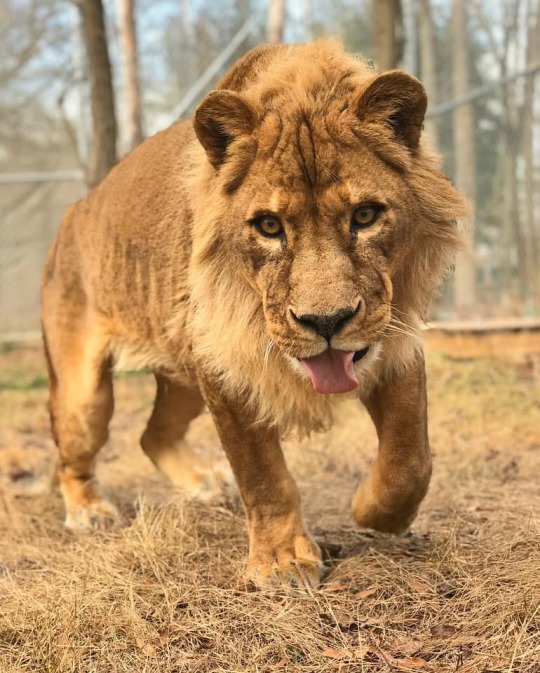
I don't know exactly when she started growing her mane, but she was over 20 years old when she passed in 2019 with these luscious locks.
Here's another female at the same facility, named Adeena. On the left is a photo of her from 2021, on the right is from this spring (I think she's mid-sneeze in the photo). She turns 20 in October.
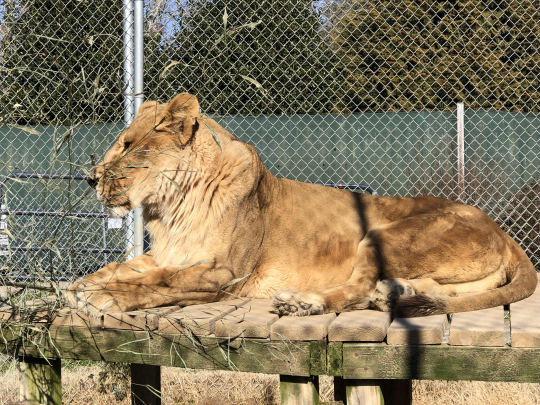
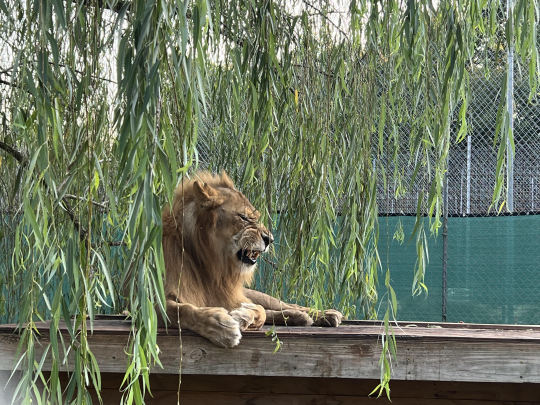
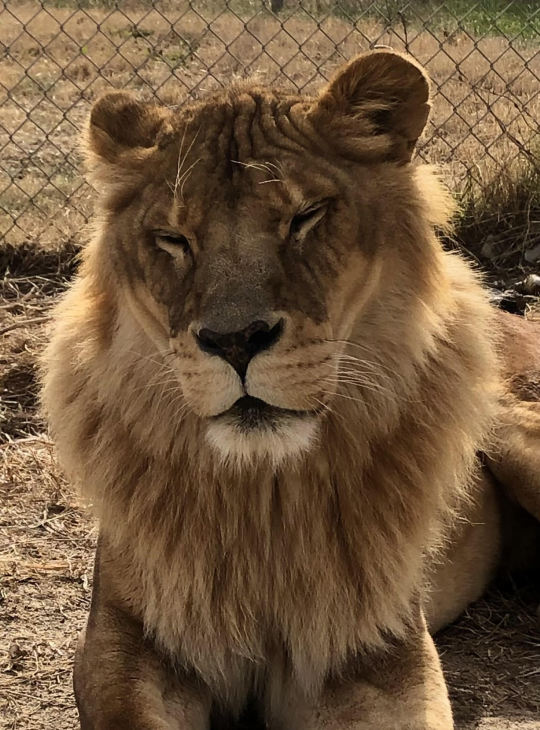
If you've heard about maned lionesses before, it’s probably because of Zuri, at Topeka. She’s the most recent one to get media coverage and she went a little viral.

(Just a side note here, but I have some strong feelings about knowledge loss in the exotic animal management world due to political/philosophical schisms. This is one of those topics where it's clear: Topeka told a reporter that the zoo had “never" heard of this happening before, but it's common enough to be well known as a thing in other sectors of the exotic cat world. There's so much expertise and knowledge being lost due to infighting between accrediting groups, and it drives me up a wall).
Anyway. Zuri had one of the best manes I've seen on an elderly lioness. It grew long and lush and she totally could have done shampoo commercials. I mean, look at this.

Zuri lived with her sister, who didn't grow a mane in her old age. Here's the two of them together, Zuri on the left, Asante on the right.

We don't completely know what's going on with these golden girls to cause them to grow manes. It's theorized to be related to the end of estrus and higher levels of androgenic hormones, although it's not clear if that's just due to lower levels of other hormones during "meownopause" or if there's something else also going on.
There was some speculation with Zuri's mane growth that it was caused by the death of the male she lived with, in some biological need to "take over the role." The zoo dismissed that idea pretty quickly, and it makes sense, although there is one other instance where I've heard of that happening before.
The cat people I've talked to say that older lionesses who grow manes don't tend to act differently - they're not taking over new social roles in their prides or anything. Sometimes they can be less active, or be a little more nervous around males, and want to be left alone more, but it was emphasized to me that those behaviors could also just be associated with the fact that manes tends to develop in elderly lionesses.
The mane growth can happen pretty quickly, as we saw in the photos I've posted of Tandie over the last year. Here's Bridget, from the Oklahoma Zoo. The left photo was taken in March of 2017 and the right in November - look how much hair she gained over six months!

The zoo did some research into what might have cause Bridget's mane growth, and found that she had elevated levels of androstenedione, which is a hormone that can be converted by the body into either testosterone or estrogen, depending. In AFAB people, it's known to have a masculinizing effect. The zoo theorized that this was the cause of her mane growth, and that the elevated levels might have been caused by a benign tumor. Fascinatingly, though, blood draws revealed that her testosterone levels were the same as her mane-less sister, Tia.
Tia is on the left in the photo below, Bridget and the beginnings of her mane are on the right. Bridget was 17 when her mane started growing in.
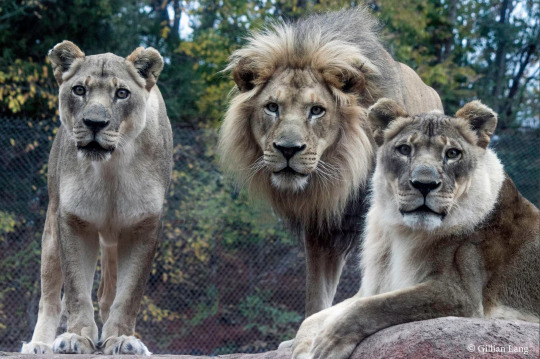
I don't think there's any formal hypothesis that there might be a genetic component to lionesses growing manes in old age, but it's interesting to note that one of Tia's daughters, Zari, also grew a mane. (And she grew it young! It started around age 13, interestingly, also right after their male died). She's on the left in the photo below.
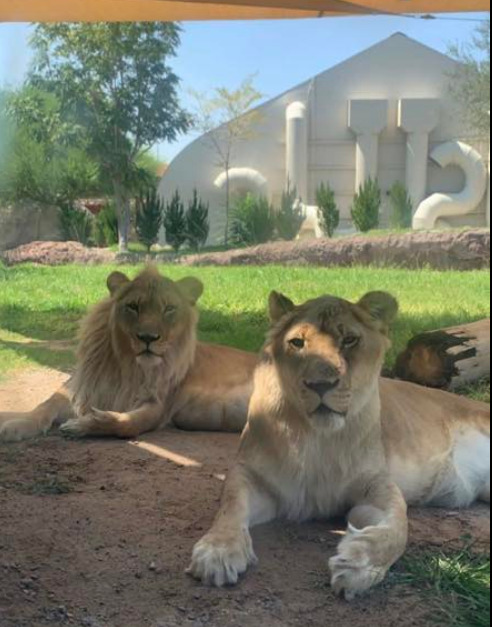
And to circle back around to where we began: Tandie is related to a number of maned ladies! His father, Xerxes, was Bridget's son; Zari was Xerxes' half-sister.
Here's a few more beautiful maned ladies to leave you with. In order, Ngala, Pepper, Skye, and Dandy Lion.
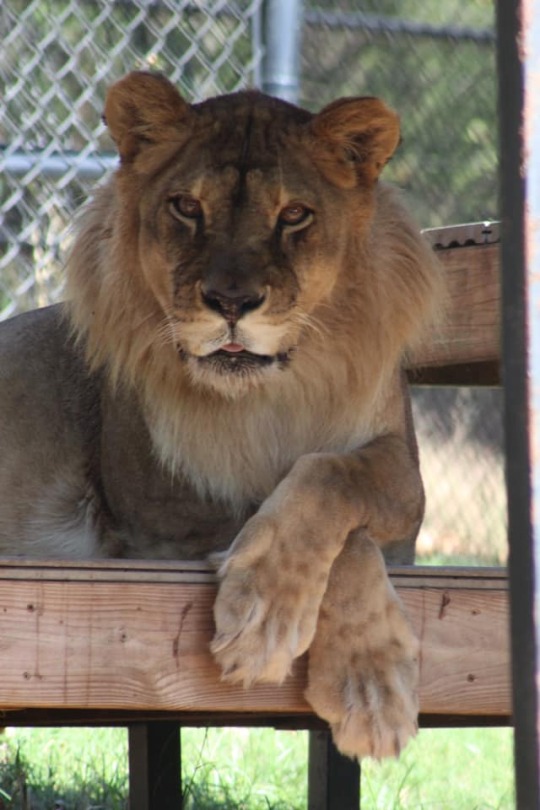


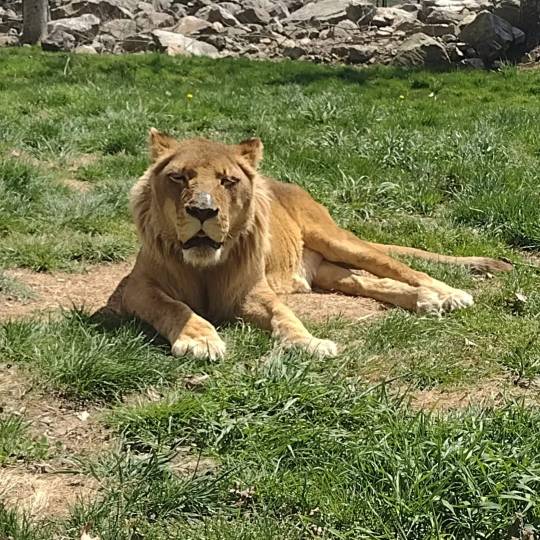
Next up, and last in this lion mane series, is the story of five younger lionesses in Botswana who not only have manes but also express a range of masculine behaviors.
.
.
.
A huge thanks to all the folk who shared photos of and stories about their golden girls for this post: M. Townsen, S.W. Simpson, E. Day, S. Cook, M. Stinner, M. Paul, K. Vanaman, D. O'Halloran, R. Simpson, D. Souffrant.
2K notes
·
View notes
Text

Cepheus. Cosmic Zoo
2K notes
·
View notes
Text
Good News - July 8-14
Like these weekly compilations? Tip me at $Kaybarr1735! And if you tip me and give me a way to contact you, at the end of the month I'll send you a link to all of the articles I found but didn't use each week!
1. Zoo welcomes birth of four endangered horse foals
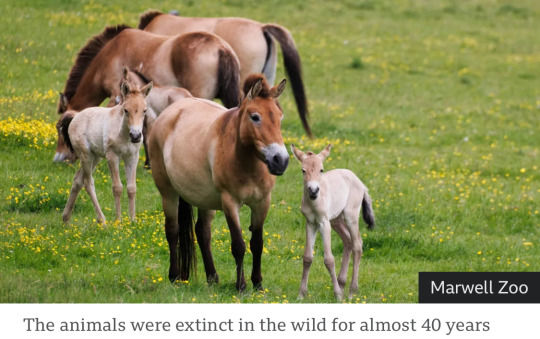
“[The Marwell Zoo in GB] said it was "delighted" to welcome the arrivals to the endangered Przewalski’s horse herd. All four are female and said to be "doing well" after two were born in May and two in June. […] “These horses, that were previously listed extinct in the wild, are an example of how zoo breeding programmes can help restore threatened species around the world.” […] All the Przewalski’s horses alive today are descended from just 12 individuals. Current estimates suggest there are 178 mature individuals living in the wild.”
2. Restoring woodlands and planting trees for sustainability success

“In 2023, [the Marwell Zoo] planted 9,000 new trees […] both within the zoo and on our surrounding land. […] Marwell tries to encourage natural feeding behaviour and nutrition by including leafy material [in animals’ feed] as much as possible. […] Planting more trees and enhancing management of our existing woodlands, prepares the way to further self-sufficiency in browse production in the future. Plus, it creates new habitats for wildlife in our woodland areas.”
3. Inclusive Playgrounds Allow Children Of All Abilities To Play

“With ramps allowing children in wheelchairs to ascend the central play structure, as well as numerous other swings and apparatus usable for children of all abilities, the 16,000-square-foot P.K.’s Place is St. Paul’s first fully inclusive playground. […] To be universally accessible, a play area must have at least 70% of its play features fully accessible, far more than required by the Americans with Disabilities Act (ADA). […] Play areas should allow parents and grandparents with disabilities to participate as well.”
4. Combination treatment can increase human insulin-producing cells in vivo
“[Diabetes-model mice] were treated with the combination therapy [of a plant product called harmine and “a widely used class of type 2 diabetes therapy”] and their diabetes was rapidly reversed. Strikingly, human beta cell numbers increased by 700 percent over three months with this drug combination. "This is the first time scientists have developed a drug treatment that is proven to increase adult human beta cell numbers in vivo. This research brings hope for the use of future regenerative therapies to potentially treat the hundreds of millions of people with diabetes," said Dr. Garcia-Ocaña, the paper's corresponding author.”
5. Decades of Dedication: Australia’s Largest Ongoing Urban Restoration Project

“[Friends of Lake Claremont] has transformed the area into a thriving ecosystem, re-establishing native habitats and fostering biodiversity. This year, 800 native seedlings (100 trees, 350 shrubs and 350 ground covers) have been planted on the northwestern buffer of Lake Claremont. Volunteers replaced a large Port Jackson fig (Ficus rubiginosa) affected by [beetle] infestation with native plants to enhance the local wildlife habitat, thereby benefiting insects, frogs, birds and brown bandicoots. […] Overall, the project contributes to the area’s function as a regional ecological corridor, linking inland bushlands, the Swan River and the Indian Ocean.”
6. Important habitat for fish in Heart of the Fraser now conserved

“British Columbia’s iconic salmon now have more protected spawning habitat in the lower Fraser River, thanks to the Nature Conservancy of Canada’s (NCC’s) conservation acquisition of Carey Island. […] Carey Island and its gravel channels offer calm and crucial spawning and rearing habitat for the river’s fish and aquatic species. […] The Pelólxw Tribe […is also] actively working to restore the resilience of aquatic habitat within this stretch of the Lower Fraser. NCC is exploring opportunities to collaborate with the Pelólxw Tribe in support of their vision for stewardship of the area, which prioritizes both ecological and cultural values.”
7. Prime editing efficiently corrects cystic fibrosis mutation in human lung cells
“[R]esearchers have developed a gene-editing approach that efficiently corrects the most common mutation that causes cystic fibrosis, found in 85 percent of patients. With further development, it could pave the way for treatments that are administered only once and have fewer side effects. The new method precisely and durably corrects the mutation in human lung cells, restoring cell function to levels similar to that of Trikafta [the standard treatment since 2019].”
8. Montana’s High Court Considers a Constitutional Right to a Stable Climate
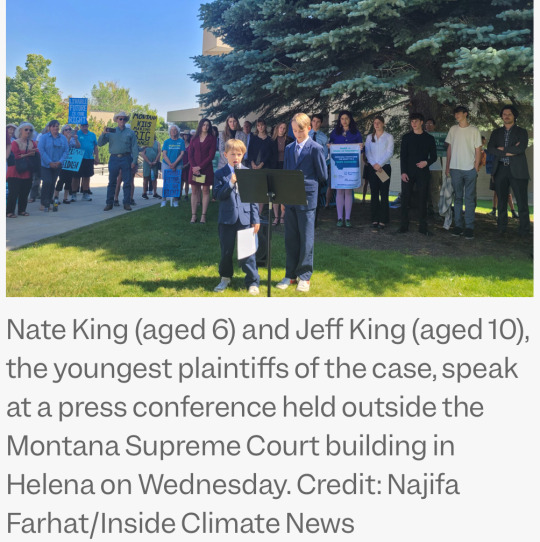
“At issue was the appeal of a decision last year, when a Montana judge blocked a state law that prohibited agencies from considering climate impacts when deciding whether to approve fossil fuel projects such as new power plants, pipelines or mining. The ruling, by District Judge Kathy Seeley, was prompted by a lawsuit filed by 16 youths who argued that the law violated Montana’s constitutional right to a “clean and healthful environment.” It was the first ruling in the United States to effectively establish constitutional rights to a stable climate[….]”
9. The US is about to get its first solar-covered canal

“The first canal-based solar project in the U.S. is nearing completion on tribal lands south of Phoenix, Arizona. […] The long, narrow solar array design would snake along the line of the canal and tap into the local electrical distribution grid every 1,000 feet, or every one megawatt. […] “Canal solar allows for greater power production per land size, cleaner water, less power transmission losses, and significant reduction in evaporation[….]” Covering the entire 8,000 miles of canals and waterways managed by the Bureau of Reclamation with solar panels could generate over 25 gigawatts of renewable energy and reduce water evaporation by tens of billions of gallons[….]”
10. Camera traps offer glimpse of first beaver born in Northumberland for 400 years
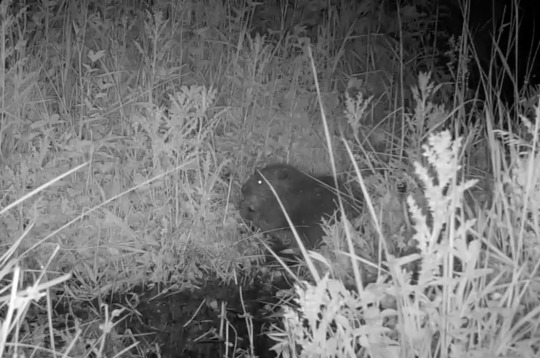
“"It’s such a relief that they have bred successfully and to see a new fluffy kit swimming with the family[….]” In just one year [since releasing the beavers], there has been a noticeable increase in resident trout, says the National Trust, along with more regular visits from kingfishers and grey herons. There are more insects at the site, too, thanks to the organic matter that builds up behind the dams, which in turn provides food for Daubenton’s bats. […] Beavers also play an important role in creating habitats that are more resilient to the effects of climate change[….]”
July 1-7 news here | (all credit for images and written material can be found at the source linked; I don’t claim credit for anything but curating.)
#hopepunk#good news#horse#zoo#nature#extinct species#sustainability#forest#children#disability#playground#disabled#wheelchair#diabetes#medicine#science#urban#biodiversity#ecosystem#fish#first nations#cystic fibrosis#gene editing#climate change#climate#youth#human rights#solar panels#solar energy#beaver
330 notes
·
View notes
Text

Can anyone else relate?
#tumblr memes#memes#meme#speculative biology#meme humor#speculative evolution#specevo#spec evo#specbio#spec bio#speculative zoology#spec zoo#relatable meme#relatable memes#relatable humor#funny stuff#funny#funny shit#funny post#funny memes#ha ha funny#funny meme haha#funny meme xd#humor#humour#science memes#science humor#art meme#shitpost#shitposting
288 notes
·
View notes
Text
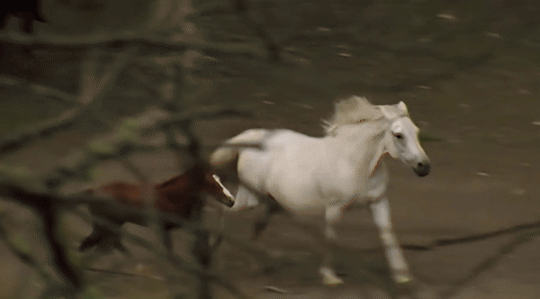
#horses#horse#animals#mustangs#science#education#nature#photography#animal#landsccape#cute animals#funny#lol#adorable#landscape#paradise#explore#gifs#beautiful#beauty#primates#zoos#mammals#wild animals#wildlife#mountain#incredible#running#wetland#river
402 notes
·
View notes
Text
“And we're not doing ourselves or our dogs any favor by pretending that any of this is normal.
And so again, to contextualize the anthropocene and the world we are living in is absolutely unprecedented. The rate of change that is still occurring and frankly, even speeding up now, it's never occurred in the history of the planet before. And we are like, this is normal.
No, none of this is normal. None of this was here 100 years ago. And like we haven't evolved and our dogs haven't evolved to those conditions.
But as we're kind of putting out all these messages and signals, like on TV and social media and whatever, that like, this is normal. And if you're not getting along with this, then like, I don't know what's wrong with you.
When the truth is, is that the research that's coming out on humans, you know, there was a study I just heard about this week where, you know, they pulled a few thousand teenage girls and over 65% of them felt completely and totally helpless.
But on the outside, we're posting on social media, little smiles and all the fun things we're doing. And our whole, those three circles for us, like, are so compromised as well. I mean, I kind of put this out a few decades ago, and I made myself so depressed in the process, I stepped away from it, but it doesn't mean it's any less true.
The idea that dogs are kind of an indicator species for us, right?
They're like the dog in the coal mine, because they're like screaming for help, rather than telling themselves, this is all perfectly normal, I must be the problem, that I'm not fitting in.
Like dogs don't flip it back on themselves in that way, automatically, you know?
Whereas we're like, I'm broken, I'm not working, where it's like, no, this whole world isn't working. And like, this is where I actually think, this is what's so inspiring about this moment, if we can lean into it. We have an opportunity to help ourselves and our dogs.
And in a way, it's almost easier to look at the dogs first. It's really hard to put the microscope back on ourselves.”
From Cog-Dog Radio: Consequences of Captivity with Kim Brophey, 22 Jan 2025
https://podcasts.apple.com/au/podcast/cog-dog-radio/id1128562867?i=1000684853950&r=2649
This part was a massive highlight from the discussion between Kim Brophey and Sarah Stremming about our dogs being captive animals - but also humans being captive in the system of capitalism!!!
This is what I’ve been saying for years in the anti vs pro zoological facilities discussions. We think we’re free but we’re not. While we are not living in physical cages we are caged by the systems that a select few have created to benefit themselves.
We are living in captive environments where we have limited autonomy because our whole system of existence is based in working to make money and creating a culture of hyper individualism that is extremely unnatural and unhealthy for social species!
Our dogs being indicator species was something I had never considered before but it makes so much sense. Just like our dogs have been unable to biologically adapt to the rapidly changing world, we are too!
38 notes
·
View notes
Text
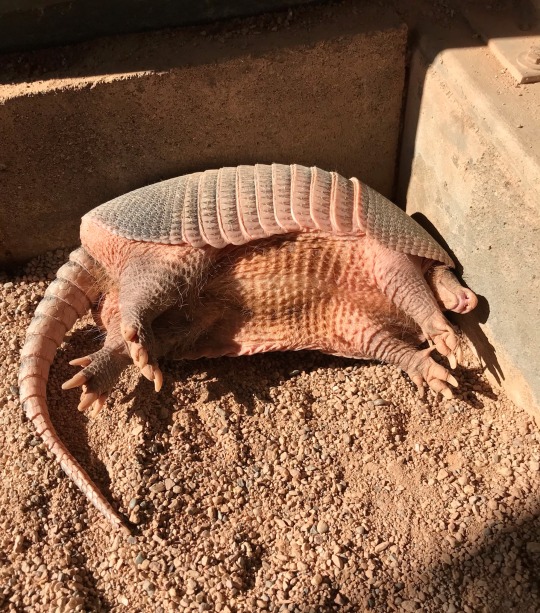
The nine-banded armadillo I work with was being so cute I couldn’t help but show her off. Her name is Delilah and she was enjoying a morning sunbathing!
280 notes
·
View notes
Text
Tremor Causes in Felines
Genetics
Trauma
Congenital issues
Certain drugs
Severe weakness
Severe pain
Kidney failure
Hypoglycemia
Toxicity
Inflammation
Nervous system disease
.
Patreon
#studyblr#notes#my notes#vetblr#veterinary science#vet science#vetsci#vet sci#the cat#cats#felines#cat breeds#cat health#cat physiology#medicine#health#cat medicine#animal science#animals#zoology#zoo science#felids#life science#health science#biology#biology notes#bio#bio notes#cat biology#cat bio
3 notes
·
View notes
Text
Early tetrapod paludarium

#biology#dinosaur#dinosaur art#dinosaurs#fossils#geology#mesozoic#palaeoart#palaeontology#paleoart#devonian#scientific illustration#sciart#paleozoo#paleontology#tetrapod#tiktaalik#ichthyostega#science#zoo#aquarium#oceanarium#terrarium#paludarium
226 notes
·
View notes
Text

USA 1993
#USA1993#BRODERBUND#BINARY ZOO SOFTWARE INC.#ARTECH DIGITAL ENTERTAINMENTS INC.#EDUCATIONAL#IBM#MYSTERY AT THE MUSEUMS#WILD SCIENCE ARCADE#ROCK AND BACK STUDIO
18 notes
·
View notes
Text





Marlin Perkins – Scientist of the Day
Marlin Perkins, an American zoologist, was born Mar. 28, 1905, in Carthage, Missouri.
Read More
#Marlin Perkins#nature on television#zoos#histsci#histSTM#20th century#history of science#Ashworth#Scientist of the Day
13 notes
·
View notes
Text

Here’s my personal recommendation of a YouTube video to check out:
youtube
#all tomorrows#cm kosemen#speculative evolution#speculative biology#speculative zoology#spec evo#specevo#spec bio#spec zoo#future evolution#posthuman#summery#comedic#comedy#science fiction#scifi#tumblr recommendations#recommend#recommendation#youtube#youtube content#youtube recommendations#youtube video#video recommendation#youtube links#youtube link#video link#video links
125 notes
·
View notes
Text
These Parrots Won’t Stop Swearing. Will They Learn to Behave—or Corrupt the Entire Flock?
A British zoo hopes the good manners of a larger group will rub off on the eight misbehaving birds
A few years ago, a zoo in Britain went viral for its five foul-mouthed parrots that wouldn’t stop swearing. Now, three more birds at Lincolnshire Wildlife Park have developed the same bad habit—and zoo staffers have devised a risky plan to curb their bad behavior. “We’ve put eight really, really offensive, swearing parrots with 92 non-swearing ones,” Steve Nichols, the park’s chief executive, tells CNN’s Issy Ronald...
#parrot#zoos#bird#ornithology#animal behavior#animal communication#nature#animal intelligence#science
55 notes
·
View notes
Text
Bronx Zoo
My brother says he wants to relive being 8 and we’re at the dinosaur exhibit but when he was 8 I had a Dinosaur hyperfixation! So now I’m saying dinosaur facts to the tune of Starkid songs.
#bronx zoo#bronx (nyc)#theropod#science facts#starkid#hatchetverse#hatchetfield#team starkid#starkid musicals#starkid productions
8 notes
·
View notes